Patterson I (Destroyer No. 36)
1911-1934
Daniel Todd Patterson was born on Long Island, N.Y., on 6 March 1786. John Patterson, his father, emigrated from Ireland to America in the 1750s and was the younger brother of Walter Patterson, the first Royal Governor of Prince Edward Island. His mother Catherine (née Livingston) was the daughter of Robert Livingston. As acting midshipman, he joined the sloop of war Delaware on 11 June 1799, to cruise against French privateers and warships in the West Indies to August 1800. He was appointed a midshipman on 20 August 1800, though his warrant was subsequently altered to date from 11 June 1799, his initial posting as acting midshipman. On the close of the Quasi-War with France, he resumed nautical studies, and then served blockade duty off Tripoli in the frigates Constellation and Philadelphia. Captured when Philadelphia grounded and surrendered on 13 October 1803, he remained a captive of the Barbary pirates until the American victory over Tripoli in 1805. Upon returning home, he spent much of his following years on station at New Orleans where he took command after the outbreak of the War of 1812.
On 16 September 1814, Patterson raided the base of the pirate Jean Lafitte at Barataria Bay, La., capturing six schooners and other small craft. That same month, he refused Andrew Jackson’s request to send his few ships to Mobile Bay where Patterson knew they would be bottled up by a superior British fleet. Foreseeing British designs against New Orleans almost two months before their attack, Patterson, not Jackson, was the first to prepare to defend the city. The victory resulted as much from his foresight and preparations as from Jackson’s generalship. His flotilla delayed the enemy until reinforcements arrived and then provided crucial naval gunfire support in defense of the entrenchments from which Jackson was never driven. Patterson, highly commended by Jackson, received a note of thanks from Congress and was promoted to captain on 28 February 1815.

Patterson remained on the southern stations until 1824, when he became fleet captain and commanding officer of the flagship Constitution in Commodore John Rodgers’ Mediterranean Squadron. Returning home in 1828, he was appointed one of the three Navy commissioners. Later, he commanded the Mediterranean Squadron (1832-1836) and then became commandant of the Washington Navy Yard in 1836, a position of responsibility he held until his death at Wilmington, N.J., on 25 August 1839. Patterson was interred at the Congressional Cemetery of Washington, D.C.
I
(Destroyer No. 36: displacement 787; length 203'11"; beam 27'; draft 8'4"; speed 29 knots; complement 89; armament 5 3-inch, 6 18-inch torpedo tubes; class Roe)
The first Patterson (Destroyer No. 36) was laid down on 29 March 1910 at Philadelphia, Pa., by William Cramp & Sons; launched on 29 April 1911; sponsored by Miss Georgeanne Pollock Patterson, daughter of Rear Adm. Thomas Harman Patterson and granddaughter of Commodore Daniel Todd Patterson; and commissioned on 11 October 1911, Lt. Cmdr. John M. Luby in command.
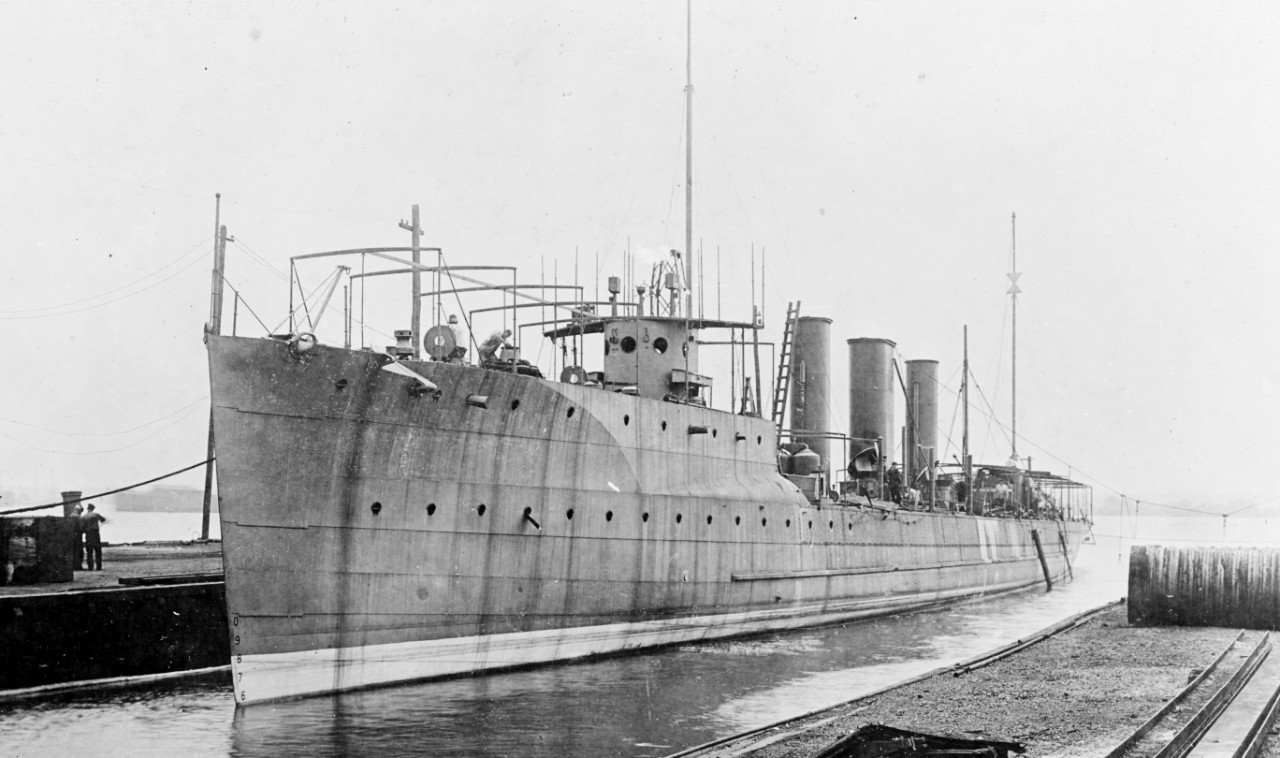
Assigned to the Torpedo Flotilla, Atlantic Fleet, Patterson departed Philadelphia on 23 October 1911, calling at Newport, R.I., and New York, before arriving at Boston on 2 November, her homeport for operations off the New England coast, the Virginia capes, and south to Charleston, S.C., Pensacola, Fla., and Guantanamo Bay, Cuba. She arrived off Vera Cruz from Pensacola on 20 May 1914 and headed home four days later. The destroyer conducted tactical exercises and mine sweeping training off Long Island from 1 July to 22 July 1915. Later, she operated from Rosebank, Staten Island, N.Y. on neutrality duty (7-11 September).
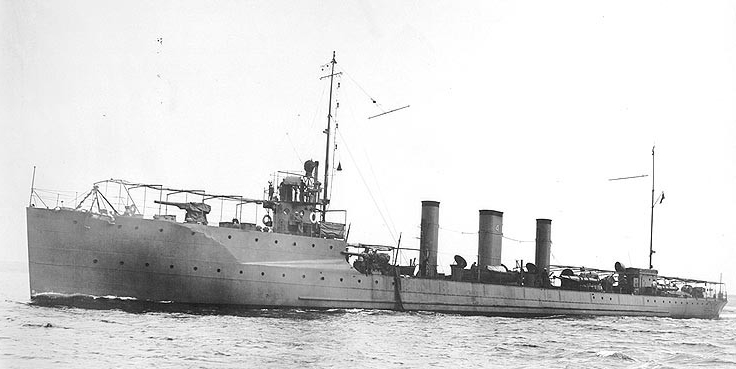
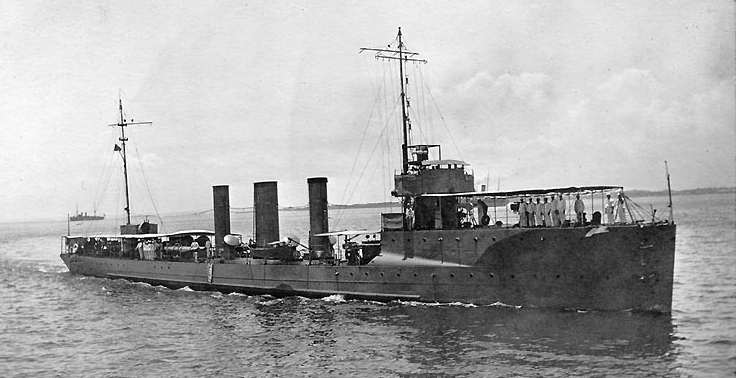
Patterson spent much of January 1916 conducting training and evaluations. She was at Lynnhaven Roads, Va. for war maneuvers (10-11 January), then moved on to Culebra Island, Puerto Rico, for further war maneuvers on 15 January and later, she was at Guantanamo Bay, Cuba, participating in engineering competitions (21-26 January). While deployed to the West Indies, the destroyer also reconnoitered Puerto Rican ports (1-9 March). Afterward, she returned to duty on the Eastern seaboard and was back at Rosebank conducting neutrality duty on 1 July.
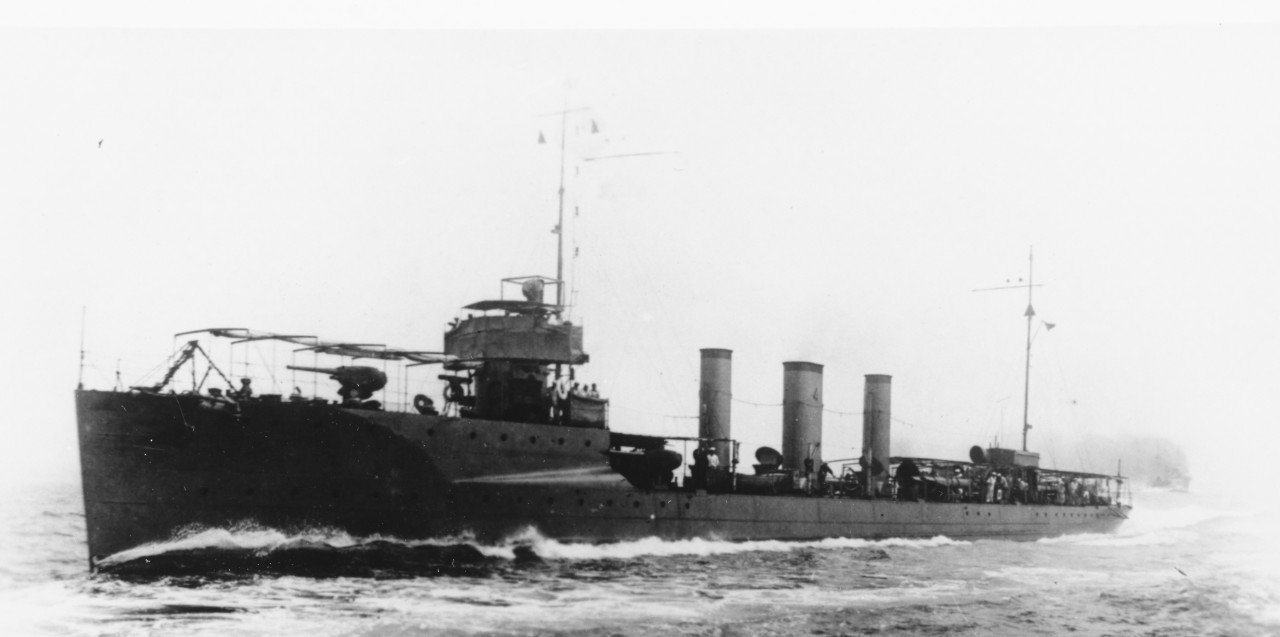
With the increase of tensions between the United States and Imperial Germany after the latter’s return to unrestricted submarine warfare, the Navy geared up for war. As part of this process, Patterson was placed into full commission on 22 March 1917, Lt. John H. Newton, Jr., in command. On 6 April, the U.S. declared war on Germany and the next day, 7 April, found Patterson at the Boston Navy Yard, Charlestown, Mass., on dispatch duty cooperating with Warrington (Destroyer No. 30). On 8 April, the two destroyers began patrolling in order to provide safe conduct to trans-Atlantic shipping in the area from Grand Sable to the Nantucket Light Vessel.
On 14 April 1917, Patterson shifted to Newport to be painted with numerals on her bow, reduced bright work on her torpedo tubes, and to be painted in a scheme to make her detection more difficult. Two days later, 16 April, she resumed patrol and escort duties off Nantucket, but returned to Newport for repairs to her starboard low pressure turbine. She then moved on to Boston for further repairs via the Cape Cod Canal on 19 April and remained there until 5 May. The next day she resumed her patrol duties, but returned to Boston on 8 May to prepare for distant service.
During that period the crew conducted exercises and drills and saw changes in personnel. On 21 May 1917, she departed Boston as flagship of the Fifth Division in company with Drayton (Destroyer No. 23), Paulding (Destroyer No. 22), Warrington, Jenkins (Destroyer No. 42), and Trippe (Destroyer No. 33). After steaming to a position 50 miles east of Cape Cod on 21 May, the division commander opened his secret orders, after which, the force proceeded towards St. Johns, Newfoundland, holding target practice and drills en route. Arriving at St. Johns on 24 May, Patterson received oil from Maumee (Fuel Ship No. 14). Two days later, on 26 May, the Fifth Destroyer Division departed St. Johns bound for Queenstown [Cobh], Ireland. Maumee initially accompanied the division, but soon returned to St. Johns.
On 1 June 1917, the British destroyer HMS Narwhal met and escorted the division to Queenstown, and upon arrival the division commander reported his ships ready for immediate service. All ships stood in excellent condition. Soon thereafter, the destroyers received British code books and were equipped with depth charges. Radio operators and quartermasters, meanwhile, received instruction in signals and codes on board Melville (Destroyer Tender No. 2). The division then began patrol and escort duties out of Queenstown on 5 June.
Patterson began patrol and escort duties in the approaches to Queenstown on 5 June 1917. On 12 June, in company with Porter (Destroyer No. 59) and Wainwright (Destroyer No. 62), Patterson escorted the destroyer tender Dixie heading for Queenstown; at 7:25 a.m. she left the tender at Daunt Rock Light Vessel and returned to her patrol area where she sighted considerable wreckage to include spars, small boats, bales, lumber, etc. She soon intercepted an S.O.S. from Indian stating that she was being chased by a submarine, and immediately increased speed to 20 knots to go to the merchantman’s assistance. While en route, she received another message from then same imperiled vessel stating that torpedoes fired at her had missed. Some 15 miles west of Indian, Patterson sighted the submarine on the surface, her conning tower clearly visible, two points on the port bow at 51º04'N latitude and 10º17'W longitude. The destroyer increased speed to 25 knots and headed toward the submarine which submerged when Patterson was about 8,000 yards away. Since the U-boat had submerged directly in the rays of the sun, the destroyer could not estimate the submarine’s position to drop depth charges. In short order, Ericsson (Destroyer No. 56) and Tucker (Destroyer No. 57) arrived on the scene and took Indian under escort.
Two months later, on 16 August 1917, Patterson dropped a depth charge on a heavy oil slick while en route to escort the steamship New York. Bubbles were seen rising and fresh oil observed at two different points. The preceding day two British “P” boats (patrol boats) had reported having seen a periscope 4 miles south of Daunt Rock Light Vessel and had dropped depth charges. It was believed that the oil slick observed by Patterson may have been that U-boat. The destroyer dropped a depth charge at 51º29'N latitude, 8º22'W longitude with no apparent results.
A collision with His Majesty’s tug Dreadful at the entrance to Berehaven Harbor, Ireland, the night of 1 January 1918, damaged Patterson’s bow. The next day, 2 January, the destroyer pulled alongside the submarine depot ship HMS Ambrose for temporary repairs. She then moved on to Queenstown on 5 January, arriving the next day. Patterson then moved onto the dry dock at Rushbrooke on 7 January and lay undergoing repairs until 31 January. Upon completion, she returned to her regular escort and patrol duties on 5 February. Two days later, she rescued twelve survivors of the British steamship Mexico City, torpedoed by U-101 (Kapitänleutnant Carl-Siegfried Ritter von Georg, commanding), while transiting between Liverpool and Milford Haven en route to joining a convoy bound for Alexandria, Egypt. Patterson transferred the survivors to a tug and then resumed her escort and patrol duties.
On 19 March 1918, Patterson joined a convoy of ten ships and the British auxiliary cruiser HMS Montague. Manley (Destroyer No. 74) approached Montague to give the latter copies of orders regarding the convoy. The impact of Manley’s stern being drawn against Montague’s as the ships neared each other jarred loose the depth charge carried in the thrower on Manley’s after deck house. The charge dropped between the two ships and the resulting explosion caused all the depth charges to explode killing many of the crewmen and causing a fire on both ships. Patterson sent her whaleboat to the scene and it returned with four of the wounded men. She was then detached to remain with the convoy which continued on its course while the remaining escorts stood by the damaged vessels.
Patterson and Paulding received orders to hunt for U-boats in the Irish Sea on 6 May 1918. She then shifted to Liverpool and entered the wet basin to have depth charge tracks installed (9-12 May). The destroyer resumed her patrol on 13 May and then returned to Queenstown on 15 May. The next day, 16 May, she received orders to proceed into the Irish Sea in order to resume patrolling.
On 19 May 1918, Patterson, in company with Allen (Destroyer No. 66) dropped depth charges that drove away U-101, a joint piece of work that elicited praise from British Admiral Sir Lewis Bayly. She continued to patrol out of Queenstown until 3 June, then sailed for the United States the following day [4 June]. Returning home via the Azores, Patterson pulled into Ponta Delgada on 7 June. After taking on provisions, the destroyer departed the next day escorting the U.S. steamship Charles Brailey on the westward transit. While en route on 10 June, Patterson parted company with Charles Brailey and set course for Bermuda. Reaching her destination on 15 June, she refueled and left for Philadelphia, Pa.
On 16 June 1918, one day out of Bermuda, she rescued survivors of the Norwegian bark Kringsjaa, sunk by U-151 (Korvettenkapitän Heinrich von Nostitz und Jänckendorff). She landed the survivors at the Cape May Naval Station and continued on to the Philadelphia Navy Yard, arriving on 18 June for overhaul. During that maintenance period, she received numerous alterations and a complete overhaul in all departments. The bridge and radio room were enlarged, submarine listening devices installed, and the depth charge tracks extended. In addition, a director fire control system was installed while the ship’s No. 5 3-inch gun was removed. All the boilers were replaced by new ones, the fuel oil tanks were perforated, a radio compass installed and a lookout station placed on the foremast. These modifications were completed on 31 July and on 13 August, Patterson departed Philadelphia for trials and to calibrate her radio compass. While underway it was discovered that both submarine listening devices failed to operate and that there were a large number of leaky rivets in the deck. She then pulled into Norfolk (Va.) Navy Yard as her orders for a trans-Atlantic trip were cancelled and she was replaced by the recently commissioned [3 July 1918] Stringham (Destroyer No. 83).

She departed Norfolk on 17 August 1918 for Tompkinsville, Staten Island, N.Y. arriving the next day, and reported to the battleship Pennsylvania (Battleship No. 38) for escort duty. At 6:00 p.m. on 18 August, Patterson, along with Perkins (Destroyer No. 26) and Paul Jones (Coast Torpedo Vessel No. 10), departed New York escorting the Hampton Roads-bound battleship. All arrived without incident off the Virginia capes the next day. On 22 August, she got underway from Norfolk as flagship of the “Patterson Group,” a special hunting squadron that included 11 submarine chasers tom seek out U-boats north from the Virginia capes to New York.
Although far from the dangers inherent in European waters, operations such as those in which Patterson and her consorts were engaged carried their own hazards. At 2:30 a.m. on 27 August 1918, the U.S. Army Cargo Transport Felix Taussig sighted a vessel running darkened some 200 feet away, south of Long Island. Believing the stranger to be a U-boat, Felix Taussig’s armed guard opened a brisk fire from her 3-inch gun forward, getting off three shots in quick succession.
Tragically, the darkened vessel proved to be the U.S. submarine chaser S. C. 209, and the second shot set the 110-foot wooden warship afire. The latter flashed a red light after the third shot from Felix Taussig, but not in time to prevent the fourth and final shot from striking home and wreaking further havoc on board, with flames consuming the craft that sank in about three minutes. Felix Taussig’s after gun, a 4-incher, got off one round before the action ended as quickly as it had begun.
Felix Taussig’s gunfire killed Lt. (j.g.) Henry J. Bowes, USNRF, S. C. 209’s commanding officer, as well as Ens. George Fitz Randolph, USNRF, and 16 of her crew (14 USNRF and 2 USN) (15 killed outright and one dying of wounds), 18 souls all told. While a submarine chaser in proximity to the fatal case of mistaken identity rescued one man and took him to Lewes, Del., Patterson retrieved eight men from the sea and transported them to New York, transferring seven injured to the hospital ship Comfort.
Subsequently, Patterson dropped depth charges to drive away a German U-boat on 3 September 1918, continuing hunter-killer patrols along the eastern seaboard until the special hunting group was disbanded on 23 November 1918, less than a fortnight after the Armistice. While the submarine chasers returned to their respective stations around Hampton Roads, Patterson received orders to Philadelphia for stores.
On 1 December 1918, she departed bound for overhaul at the Boston Navy Yard, arriving the next day. From 3 December to 31 December, the destroyer saw her listening devices repaired, baffles installed in the boilers, her depth charges and “Y” gun removed, stanchions and awnings fitted, and numerous other repairs affected. Patterson entered the Philadelphia Navy Yard on 1 January 1919, lay there unassigned through most of the year, and decommissioned on 9 December 1919. After decommissioning, the ship remained at Philadelphia Reserve Basin.
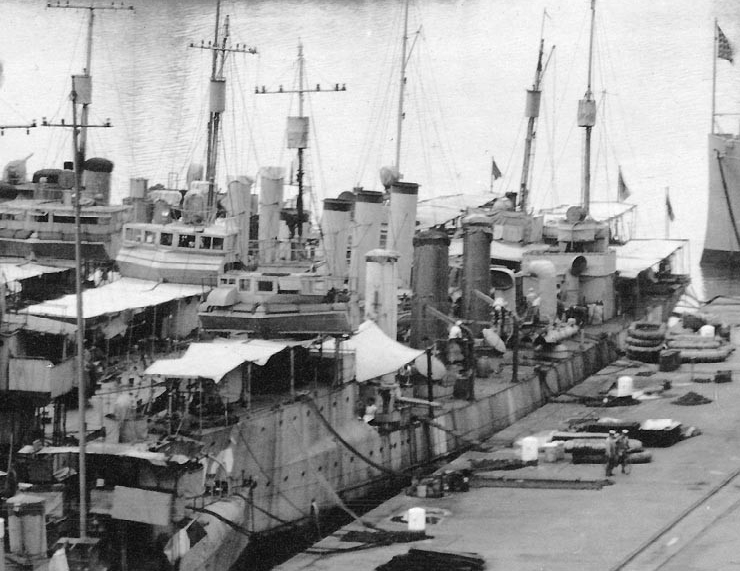
Patterson underwent a resurrection of sorts with her transfer to the U.S. Coast Guard on 28 April 1924. Patterson was one of 31 destroyers that constituted the Coast Guard Destroyer Force, established to enforce the Volstead Act (Prohibition) and interdict the illegal importation of alcohol. Adapting these vessels to service was thought to be less costly than building new ships. In the end, the rehabilitation of the vessels became a saga in itself because of the exceedingly poor condition of many of the war-weary ships.
Designated as CG-16, Patterson was commissioned at Hoboken, N.J. on 24 November 1924, Lt. Cmdr. Michael J. Ryan commanding. Initially assigned to Division Two of the Destroyer Force and homeported at the Coast Guard station at Stapleton, Staten Island, she had orders to patrol the eastern seaboard as far south as Florida. Capable of well over 25 knots, seemingly an advantage in chasing rumrunners, she was, however, easily outmaneuvered by the smaller, speedier, contact boats that ran the liquor into shore. The destroyer’s mission, therefore, was to picket the larger supply ships (“mother ships”) and prevent them from off-loading their cargo onto the smaller craft. On 28 March 1927, the destroyer seized Annetta I of New York with a hold full of illegal alcohol that included gins, cordials, and champagne. During the competitions for the Gunnery Year 1928-1929, Patterson rated thirteenth out of the 24 destroyers overall. She stood seventh in the Short-Range Battle Practice, but dropped to 20th in the Long-Range Battle Practice.
On 30 January 1930, Patterson was ordered laid-up at New London, Conn. The destroyer was eventually decommissioned there on 1 April. She was ordered towed to the Philadelphia Navy Yard on 12 August and Patterson was returned to the Navy on 18 October.
She remained inactive until her name was cancelled on 1 July 1933 in order to permit its assignment to a newly-authorized destroyer. In accordance with the London Treaty for the Limitation and Reduction of Naval Armament, she was sold for scrapping on 2 May 1934 to Michael Flynn, Inc., Brooklyn, N.Y. Patterson was stricken from the Navy list on 28 June 1934.
| Commanding Officers | Dates of Command |
| Lt. Cmdr. John M. Luby | 11 October 1911 – 27 October 1912 |
| Lt. Harold R. Stark | 27 October 1912 – 15 April 1914 |
| Lt. John H. Newton Jr. | 15 April 1914 – 13 April 1917 |
| Lt. William R. Purnell | 13 April 1917 – 24 April 1918 |
| Cmdr. Thomas A. Shanley, USCG | 24 April 1918 – 15 July 1918 |
| Lt. Cmdr. Warren C. Nixon | 15 July 1918 - 1 January 1919 |
| Lt. Cmdr. Michael J. Ryan, USCG | 24 November 1924 – 30 August 1926 |
| Lt. Cmdr. William Williams, USCG | 30 August 1926 – 16 October 1927 |
| Lt. Cmdr. Earl G. Rose, USCG | 16 October 1927 – 1 April 1930 |
Christopher B. Havern Sr.
29 June 2017


